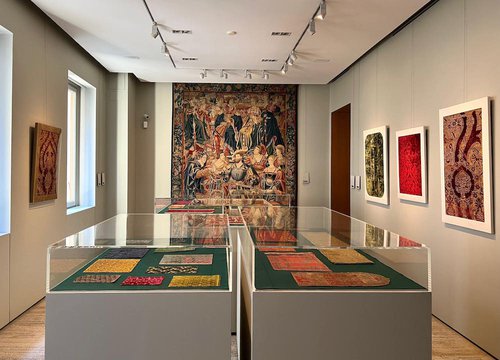On the occasion of Milano MuseoCity 2025, Gallery Moshe Tabibnia and Fondazione Antonio Ratti come together to create an exhibition dedicated to antique textiles.
On show will be iconic works in terms of typology and decorative patterns from European textile production from the 15th to the 17th centuries. These textiles of great value and richness can be found today as fragments, small or medium-sized, some of which retain silhouettes, remains of stitching or folds that testify to their past use as clothing or furnishings.
Introducing the room is the tapestry ‘The Triumph of Esther’, from the I half of the 16th Century, where we can see in the crowded scene, great attention paid to the sumptuous robes worn by the various characters, richly embroidered and draped. In detail, the robes worn by Ahasuerus and the lady to the left of Esther, show a large pomegranate on the chest, a motif very present in the decorative repertoire of the centuries investigated in this exhibition. The pomegranate not only recalls the link with the East, but also bears witness to a symbolism that Christianity made its own, adopting the Persian matrix meaning of eternity and infusing new meanings, such as the passion of Christ, with its red juice, and the communion of saints, witnessed by the numerous grains kept inside it. This fruit, together with the pine cone and the thistle, dominate the repertoires of velvets, lampas and brocatelle from the Ratti selection. The same motifs we find transposed in the carpet of Spanish provenance from Gallery Moshe Tabibnia.
Also presented in the exhibition are figured lampas from the Ratti collection, a particular production from Lucca, dated around the beginning of the 15th Century, which saw the production of scenes depicting the life of Christ and the Madonna and which had the specific purpose of adorning the stolons and pectorals of ecclesiastical vestments.
From the large decorative patterns developed between the 15th and 16th centuries, with inflorescences and designs as large as the full height of the piece (of about 55 cm), the repertoire of flowers, fruits, plant elements from 1550 onwards becomes smaller and smaller. Furnishing textiles begin to differ from those for clothing, both in decorative pattern and in type of construction. This is the case of the Lucchese wallpaper from the Ratti collection, a brocatelle with large vertically developed ovals formed by two vine shoots with vine leaves and grapes tied by wreaths, two facing lions, a large vase from which a bouquet of flowers and two eagles are visible. The textiles on display are only a small selection of specimens from Fondazione Antonio Ratti, which has a large sample collection in terms of shapes and colours.
A case in point is the large fragment of an Italian carpet with a flamed pattern from the Moshe Tabibnia collection, which at first glance differs from the other artefacts on display, both in colour and decorative pattern. Instead, the presence of this motif is found in central Italy around the 17th Century, specifically Umbria and Tuscany, and was used in furnishing textiles.
Finally, as a comparison to European production, Chinese and Ottoman textiles also find their place in the exhibition, a few examples but extremely valuable and illustrative of the genre. The motifs are those of the botanical repertoire; in the two Chinese textiles from the Ming period (1368-1644), lotus flowers are represented in delicate gold paper yarns, while in the Ottoman ones extremely stylised palmettes, buds and tulips dominate.

